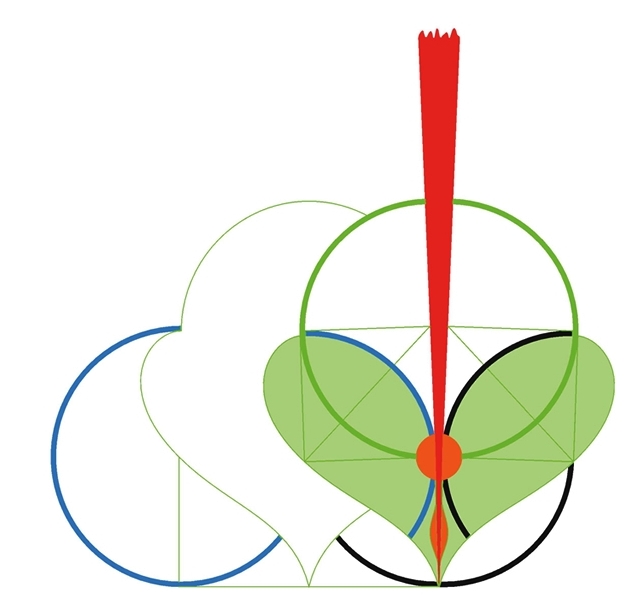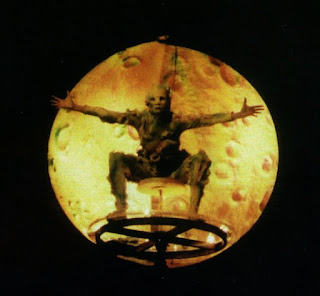Sunday from Light (1998-2003)
for 10 vocal soloists, boy’s voice, four instrumental soloists (bassett horn, flute, trumpet, synthesizer), two choirs, two orchestras, electronic music.
SONNTAG aus LICHT (Sunday From Light) is the 7th and final opera in Karlheinz Stockhausen's "7 day" LICHT (Light) opera cycle, following MITTWOCH aus LICHT. SONNTAG is characterized as the "Day of Mystical Union" between the LICHT protagonists MICHAEL and EVE. In the opening Scene of this 5-part production, an orchestra atomizes and rotates the themes of MICHAEL and EVE, after which a procession of "Angels" praises their union. The scene "Light Pictures" reflects the courtship between these two characters in a 3-way "shadow-play", and seven "Scents of the Week" are celebrated. Finally, an orchestra and choir take turns to finalize this union with "recollections" of scenes from each day of LICHT. The scenes in SONNTAG do not have a dramatic arc connecting them, instead the actual theme of union between the characters Michael and Eve are achieved through musical, visual, spatial and even olfactory means.
Scene 1: LICHTER–WASSER (SONNTAGS-GRUSS)/(Light-Waters, or Sunday Greeting)
For soprano, tenor, and orchestra (29 pcs.) with synthesizer. Composed 1998-1999, premiered 1999 during the Donaueschinger Musiktage (Southwest German Radio).
After an introductory duet, the tenor and soprano soloists lead members of the orchestra to appointed locations situated throughout the audience seating area. After each player has reached his/her spot, a candle is lit (the "Light" of the title). During this opening ritual a complex harmony slowly builds from broad held figures. The main section of this Scene is characterized by short melodic fragments (based in the LICHT Michael and Eve melody themes) passed around by members of the orchestra in two layers. This results in "waves" of melodies circling around the audience hall in separate tempos. This structure is interrupted by several soloistic interludes, as well as a section where some musicians "ascend" to an elevated stage for a narrative scene. At the end, each player drinks from a bowl of water (the "Water" of the title) and depart.Further Analysis and Listening Guide
Scene 2: ENGEL-PROZESSIONEN (Angel Processions)
For choir (a cappella). Composed 2000, premiered 2002 at the Concertgebouw in Amsterdam.
In ENGEL-PROZESSIONEN, the setting is a hall lined with a mixed choir along the rear and side walls (a "Tutti Choir"), singing slow, quiet tones and aleatoric syllables. Promenading through the audience are 7 singing "Angel Choirs" (choir groups of 4 to 6 singers) using texts from 7 different languages. A tenor and soprano lead the choir members in synchronized hand gestures. The 7th Angel Choir, the Angels of Joy, also sometimes sings from the balcony (echoing the "elevated" section of the 1st Scene). During this Scene, the 7 Angel Choirs sing in various vocal combinations (layered configurations of 2-part polyphony) while promenading in ritualistic fashion throughout the performance space. Since the theme of SONNTAG AUS LICHT is "mystical union", the polyphonic EVE and MICHAEL layers of each Angel Choir gradually meld together (Duality to unity) as the Scene progresses into a homophonic texture at the end, at which point each Angel Choir proceeds up the middle of the hall and converges, bringing irises and lilies to form a mountain of flowers.Further Analysis and Listening Guide
Scene 3: LICHT-BILDER (Light Pictures)
For tenor vocalist, trumpet with ring-modulation, basset-horn, and flute/alto flute with ring-modulation. Composed 2002-2003, premiered 2004.
In this Scene the tenor vocalist and basset-horn soloist navigate through "backwards-ordered" fragments of the Michael and Eve themes. The trumpet and flute play staggered variations of the tenor and bassett-horn (effectively acting as rippling "reflections). The sounds of the trumpet and flute are also processed through a digital ring-modulation effect, which adds a further "warped reflection" to the musical texture (these sounds are projected from the rear of the hall). Throughout this performance the performers also move about the space in motions reflective of the musical material. Divided into 7 sections (one for each day of the week), the polyphonic texture of this Scene is broken up by several interludes based on harmonized duos, trios and quartets. The libretto sung by the tenor soloist is made up of non-grammatical words and phrases which praise God and correspond to the "essences of seven spheres of life".Further Analysis and Listening Guide
Scene 4: DÜFTE - ZEICHEN (Scents - Signs)
For 7 vocalists, boy’s voice, synthesizer. Composed 2002, premiered 2003 at the Salzburg Festival.
In this Scene, Stockhausen celebrates each of the 7 Days of the Week with it's own Scent and an explanation of its Sign. The main body of this Scene features six vocalists singing in solos, duets and trios, each containing text describing the basic themes of each Day of the Week. During each of the 7 primary "song-scenes" incense is lit (aromatic bowl), banners are unfurled, and hand gestures are made. These songs are separated and supported by ensemble sequences in free-rhythms. A synthesizer adds various embellishments to each of the songs, becoming more and more complex as the Scene develops. At the end are 2 additional songs where a youth from the audience is taken into the sky on a flying horse (the alto song sequence also features a richly-harmonized "Overtone Chant").Further Analysis and Listening Guide
Scene 5: HOCH-ZEITEN ("High-Times", or "Wedding/Marriage")
For choir and orchestra. Composed 2001-2002, premiered 2003 at Las Palma.
HOCH-ZEITEN is performed simultaneously by both a choir and an orchestra situated in two separate halls. Since the theme of SONNTAG is "mystical union", audio/video signals are broadcast from one hall into the other during several "Blend-ins" (physically, however, the 2 musical ensembles are completely separate). Typically, an audience will experience a performance of one group in the first hall, and then move into the other hall as the performance is repeated (in other words, the performers exchange audiences between two performances of the same work). The music itself is based around held tones (drones) making a 5-part harmony (and 5 different languages for the choir), with different types of ornamentation featured. These various ornamental articulations are meant to "speak" to each other, using the 5 languages applied to the 5 layers. In addition to the "Blend-ins", the orchestral version has 7 "Memories", where a featured duet/trio occurs. Here, quotes of musical passages from previous Scenes of the LICHT opera cycle appear. These instrumental "Memories" are also heard in the choral version through the orchestral "Blend-ins".Further Analysis and Listening Guide
SONNTAGS-ABSCHIED ("Sunday Farewell")
For 5 Synthesizers. Composed and premiered in 2003.
In 2004, the music for HOCH-ZEITEN was adapted for 5 synthesizers. Five performer-programmers (Layers 1-5: Marc Maes, Frank Gutschmidt, Fabrizio Rosso, Benjamin Kobler and Antonio Pérez Abellán) worked with Stockhausen to translate the choir version manuscript into synthetic tones, while preserving the linguistic aspects of the text. When staged, video projections of the keyboardists' hands can be projected onto screens above each player. This version can also be performed by 1 synthesizer accompanied by a tape of the other 4 parts, in which case it is named KLAVIERSTÜCK XIX (Piano Piece 19). Another version of this piece exists as STRAHLEN, which is for multiple vibraphones (some processed digitally).Further Analysis and Listening Guide
Mystical Union
Sunday From Light celebrates the final convergence and joining of the protagonists Michael and Eve, and therefore minimizes the influence of Lucifer, the LICHT Cycle's antagonist. As Lucifer represents a more conservative, "restrictive" theme, his absence allows this final day of LICHT to have a very open feeling - evocative of an almost ethereal, open-air ritual celebration. Additionally, this final opera presents refined explorations of elements found in earlier points of Stockhausen's half-century career, from the "pointillistic" orchestral textures of Light-Waters (see PUNKTE), to the movement-based, ring-modulated chamber pieces of Light-Pictures (MANTRA), to the spacially-enhanced ritual drone textures of Angel Processions and High-Times (see STIMMUNG, STERNKLANG, INORI). As a final statement of the LICHT opera cycle however, the composer here unmistakably reaches an apotheosis of sorts for the LICHT superformula.
 |
| The color for SUNDAY is GOLD. |
| LIGHT-WATERS | Soprano and Tenor vocal soloists, orchestra, synthesizer |
| ANGEL PROCESSIONS | Choir a cappella (with 4 soloists) |
| LIGHT-PICTURES | Tenor vocalist, bassett horn, ring-modulated flute, ring-modulated trumpet (with synth for controlling ring modulation) |
| SCENTS – SIGNS | Vocal septet (solos, duos and a trio), boy’s voice, synthesizer |
| HIGH TIMES (MARRIAGES) ORCHESTRA VERSION CHOIR VERSION |
Orchestra Choir |
| SUNDAY FAREWELL | Tape (5 synthesizers (PIANO PIECE XIX)) |
Released on Stockhausen Edition CDs 58, 67, 68, 69, 73, 74
| Additional Arrangements from SONNTAG aus LICHT | Stockhausen Edition CD |
| ENGEL-PROZESSIONEN (TUTTI-Chor) | 67 ENGEL-PROZESSIONEN |
| MONDAY SOLO: EVE's day (CUCHULAINN) | 70 9 DÜFTE DER WOCHE (Song Extracts) |
| TUESDAY DUET: Day of Conflict between MICHAEL & LUCIFER (KYPHI) | 70 9 DÜFTE DER WOCHE (Song Extracts) |
| WEDNESDAY TRIO: Cooperation between MICHAEL, EVE & LUCIFER (MASTIX) | 70 9 DÜFTE DER WOCHE (Song Extracts) |
| THURSDAY SOLO: MICHAEL's Day (ROSA MYSTICA) | 70 9 DÜFTE DER WOCHE (Song Extracts) |
| FRIDAY DUET: Day of LUCIFER's Temptation of EVE (TATE YUNANAKA) | 70 9 DÜFTE DER WOCHE (Song Extracts) |
| SATURDAY SOLO: LUCIFER's Day (UD) | 70 9 DÜFTE DER WOCHE (Song Extracts) |
| SUNDAY DUET: Day of Mystical Union between MICHAEL & EVE (WEIHRAUCH) | 70 9 DÜFTE DER WOCHE (Song Extracts) |
| BOY'S SCENT (KNABEN-DUFT) | 70 9 DÜFTE DER WOCHE (Song Extracts) |
| HEAVEN'S SCENT (HIMMELS-DUFT) | 70 9 DÜFTE DER WOCHE (Song Extracts) |
| HOCH-ZEITEN Chor Gruppe 1-5, Tutti | 71 HOCH-ZEITEN Choral multitracks |
| HOCH-ZEITEN Orchester Gruppe 1-5, Tutti | 72 HOCH-ZEITEN Orchestra multitracks |
| STRAHLEN (2002) | 75 STRAHLEN |
















